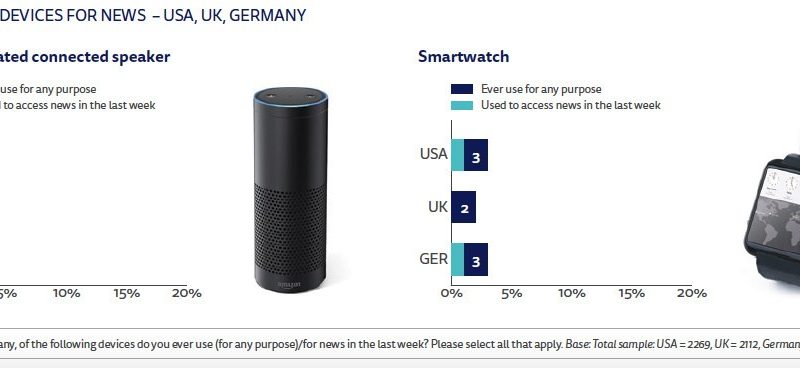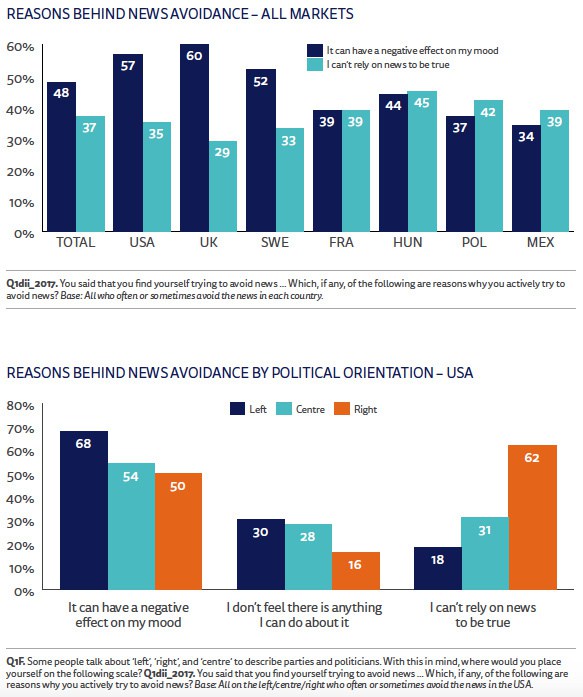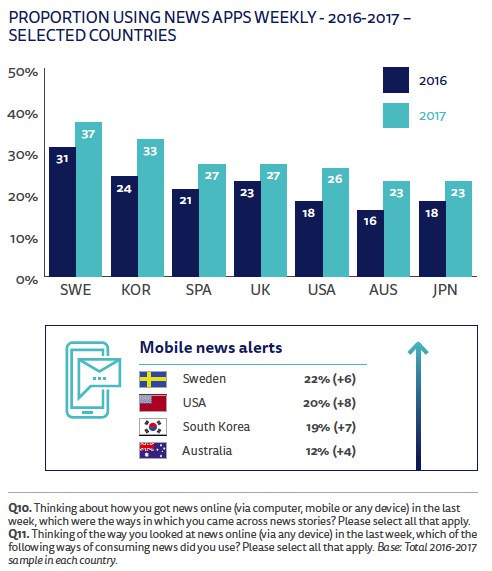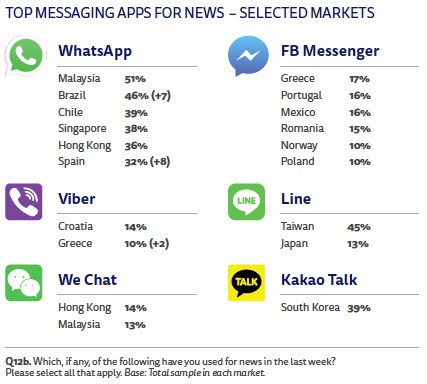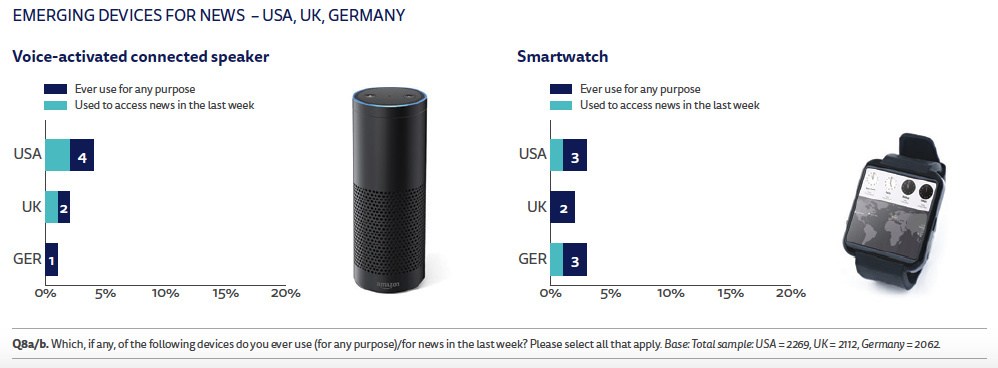U.S. Audiences More Willing to Pay for News: Voice-Activated Services the Next Frontier
The publication of the annual Digital News Report, from the Reuters Institute for the Study of Journalism at Oxford University, is eagerly awaited by news execs around the world. So much so, that the 2017 study is being accompanied by major presentations on June 22 at the GEN Summit in Vienna, and at the Tow Center for Digital Journalism at Columbia University in New York.
Clocking in at 133 pages, this sixth annual study, has been expanded to cover 36 different markets around the world (the first, in 2012examined just five countries), shedding light on many countries – including nations featured for the first time such as Mexico, Malaysia, Croatia and Romania – which are seldom reported in English-language media.
Against this backdrop it’s fascinating to determine some of the similarities – and differences – between digital news habits in the U.S. and the rest of the world. With that question in mind, here are seven important developments worth highlighting.
-
Audiences in the U.S. are more willing to pay for news than a year ago
“In terms of online news subscriptions, we have seen a very substantial ‘Trump bump’ in the US (from 9% to 16%) along with a tripling of news donations,” the report authors note. “Most of those new payments have come from the young – a powerful corrective to the idea that young people are not prepared to pay for online media, let alone news.”
Interestingly, although this growth is across all demographics – and all political persuasions – this increase is much starker among younger news users and those identify themselves as being on the left of the political spectrum.
Of U.S. consumers who had paid for online news in the past year, nearly a third (29%) declared their primary motivation as being “I want to help fund journalism.” This contrasted with 13% of paying news users around the world.
As the report notes, “it is too early to know whether these increases constitute a groundswell, or simply a knee-jerk reaction to a political shock.” With 62% of non-paying digital news consumers in the US describing themselves as “very unlikely” to pay for news in the future, this spike in subscriptions and donations may well level-off next year.
2. Trust in the media is heavily driven by your political viewpoint
“In most countries, we find a strong connection between distrust in the media and perceived political bias. This is particularly true in countries with high levels of political polarization like the United States, Italy, and Hungary,” the study states.
Americans who identify themselves on the “right” are much less likely to trust the news (20% versus 51% on the left). The reverse is true in the UK.
Overall, although trust is up +5% from last year, only 38% of all digital news users in the US say they trust the media. On this index, that means US ranks 28/36 in the study for trust in the news.
 3. Some audiences are deliberately choosing to turn off, tune out, and drop out
3. Some audiences are deliberately choosing to turn off, tune out, and drop out
In a number of politically charged environments around the world, it appears that some audiences are deliberately trying to avoid the news.
Avoidance, almost half of Reuters’ sample (48%) said, was typically driven by a sense that “it [the news] can have a negative effect on my mood,” rather than due issues of trust (37%). Nonetheless, there were substantial national variances.
In the U.S., political positioning, again, plays a prominent role. Drivers for news avoidance – depending on whether you define your political views as left or right – can be quite different.
-
Social media hasn’t killed the radio – or TV – star
Moving away from politics, our ability to consume – and discover – news content from a myriad of different sources is clearly shown in the new report.
On a weekly basis, social media as a news source overtook print in 2014. But, the report cautions, “the reality is that, for most of us, social media are not something different but increasingly just part of the everyday media mix.”
As the authors explain:
“Two-thirds of social media news users in the United States also watch television news (67%) and two-thirds also visit mainstream websites or apps (66%) – a bit more than the general population. Just 2% ONLY use social media for news in an average week.”
-
Older digital formats are also proving resilient
Our media consumption increasingly includes a wide variety of different products and services. This includes delivery platforms old and new; with many older platforms continuing to grow as they are reinvigorated for the digital age.
On a weekly basis, nearly a quarter (23%) of U.S. news consumers get news from email; the third largest market for this behind Belgium (34%) and Portugal (30%).
Meanwhile, against the odds, it appears that usage of news apps is – once again – on the increase. “This is much more likely to be about more regular usage by existing app users, rather than by some surge in new installs,” the report authors speculate.
“Two key factors are likely to be at play: (a) more publishers have enabled deep linking to apps from search, social, and email; (b) the substantial increase in mobile notifications noted earlier, as publishers pursue loyalty strategies and take advantage of new platform capabilities. It is no coincidence that the biggest increase in app use has come in counties that have seen the biggest increase in mobile notifications (US, Australia, South Korea).”
Mobile alerts – news notifications which pop-up on the locked screen – are used by 1 in 5 (20%) of US digital news consumers. This habit is most popular in Taiwan (32%), Hong Kong (27%) and Turkey (24%).
-
Many newer delivery formats are pioneered in the U.S.
A number of prominent – yet recent – delivery platforms launched first in the US, giving an indication of where other nations may follow. Examples of this include:
- Snapchat Discover: – which launched in January 2015 – has a reach of 23% with 18-24s in the US and 10% in the UK. The first non-English language version of the service launched in France last September. It already enjoys a 9% reach amongst 18-24s.
- Apple News app: Available only in the US, UK and Australia – it is now used by 25% of iPhone users in the US, up from 13% a year ago. Growth in Australia has been even more dramatic, up +17% in the past year, to also reach 25% of iPhone users.
One area where the US is perhaps notably absent, however, is in the role of messaging apps as a means for sharing or discussing the news. In this regard, South East often dominates, both in terms of innovation and mass-market adoption for news purposes.
-
Voice activated services may be the next news frontier
Services like Amazon Echo and Google Home are pretty nascent technologies, and only available in a few key markets. But, Reuters’ research suggests this platform already has a news reach which seems to exceed the smartwatch.
Voice controlled digital assistants are already being used for breaking news by CNN, and other publishers such as the Wall Street Journal and the BBC World Service, as well as German media organizations Spiegel and Bild.
Whether they’ll continue to grow – and potentially go mainstream – remains to be seen.
This article was originally published on MediaShift.

